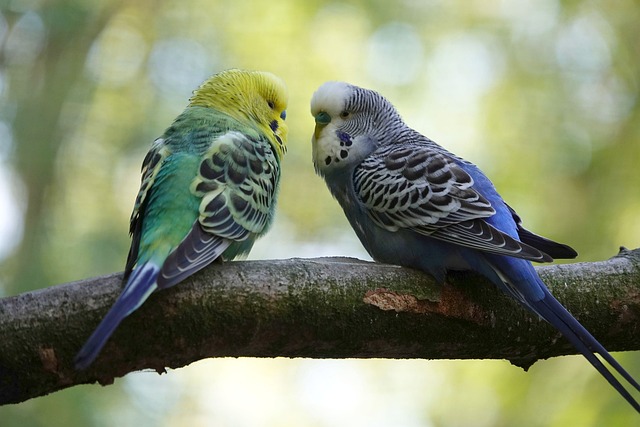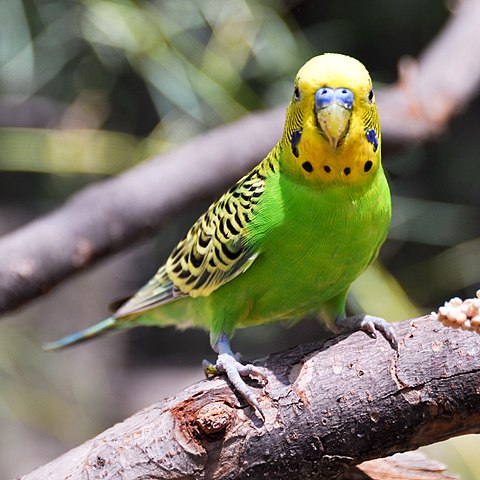Parakeets are the most common pet parrots out there since they are so easily obtainable from your local pet shop. They are most people’s first impression of parrots in general, and almost always leave a positive lasting impression!
Because of their small size, they make great first pets for kids giving them a great animal to form a bond with and train as their companion. Parakeets are trainable, just like any larger species of parrot. In fact, it’s actually a parakeet that holds the world record for having the largest vocabulary!

Although a bit harder to understand, parakeets do have the ability to learn how to mimic human speech. Not only that, they can easily learn how to do fun and socially interactive tricks like wave, spin in a circle, fetch something small enough and light enough for them to carry, and much, much more including things like a flighted recall to your finger.
Don’t let their size fool you – they’re smart and they learn extremely fast! Parakeets have been known to “sleep on it”, or in other words, learn things overnight as they have time to process the training session. One day you’re struggling through a training session, and the next day suddenly your parakeet is Einstein and understands the behavior you’re asking for from start to finish!
Because they are so intelligent and learn so quickly, they can be quite challenging to train because your timing really matters. For example, I was trying to train my parakeet to touch the end of a chopstick (what we call “touch training”) with the end of its beak, but right as I thought my bird was going to touch it with its beak, it did so and had time to put his foot on the stick and I clicked my clicker at that exact time. Because of this wrong timing of clicking, I ended up teaching my parakeet to lift his leg on a stick instead of touching it with his beak!
They are incredibly fast movers, so you have to be on your toes with your clicker when it comes to training and capturing exactly what you want! All you need to successfully train a parakeet is a clicker and a stick of spray millet which will act as your parakeet’s favorite treat!
Most parakeets love spray millet and this is why it’s important that it is not included in your bird’s everyday diet or allowed in the cage as part of a meal. Seeds, in general, are very fatty and although essential in most smaller species of parrots’ diets, it’s important that you as the trainer are the only source of something so delicious! This way your bird isn’t overeating and you remain a constantly positive force in your bird’s day.
Parakeet or Budgerigar?
In American culture, the name “parakeet” has been given to the species of parrot properly known as the “budgerigar”, or the “budgie”, for short. Technically, a parakeet is any small species of parrot with a long tail, so it can correctly be called the “budgerigar parakeet”. Confusing? Yes. Let’s just call them parakeets.
Wild Parakeets
The parakeet, melopsittacus undulatus, is a small parrot about 7″ long and weighs between 30 and 40 grams. It is native to Australia’s scrublands and grasslands but is known to travel to wooded and coastal areas when food and water are in short supply in their preferred habitats. Wild parakeets forage for food during the coolest hours of the day and seek the shaded protection of trees and bushes in the midday heat. Their diet consists mainly of grass and weed seeds, but in captivity, we also provide fresh produce and organic pellets to balance their diet.

Don’t let their size fool you!
Parakeets have gained much notoriety for their accomplishments. It is a tiny blue parakeet named Puck that has the largest documented parrot vocabulary on record (in the 1995 Guinness Book Of World Records) with 1,728 words and phrases. It is a title most parrot aficionados would have attributed to the African Grey. Being very intelligent, the parakeet is highly trainable, and like all parrots, it needs to be trained. While they aren’t capable of landing a bite that will send you to the hospital for stitches and aren’t loud enough to damage your hearing (although for what they lack in volume they can more than makeup for in persistence), your bird has one huge advantage: it can fly.
Parakeets are very adept fliers. They have the speed and maneuverability that is to be expected for a bird of their size, and they are natural masters at evading human hands. So what happens if you have a parakeet with advanced flight skills that are afraid of your hands, something not uncommon with small birds? When you think about how large your hand is compared to their tiny bodies, that fear is not unreasonable.
Even with the best of intentions, our huge hands reach into cages to “snatch up” little birds – or put them back in before they are ready to go. If you have a parakeet and it has evaded your grasp, you have, no doubt, resorted to chasing it through the house. If you have an already fearful bird, this only adds to its fear.
Frustratingly, the first thing many people do is reach for the scissors to clip the wings without any consideration of the psychological damage that occurs when you strip away a bird’s main method of mobility. A bird that cannot fly is left feeling vulnerable and this will only add to his mounting fears. Yes, he will not be able to fly away from you anymore, but he won’t want to be around you either… and you will have earned those feelings of mistrust.
